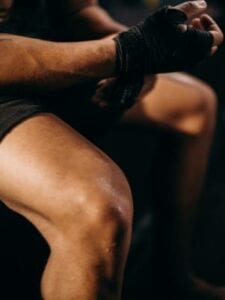From the time we are young, our knees are under a lot of stress. Between falling off your bike, jumping, walking, running, and climbing, your knees take the brunt of the force and can become painful. One of the most common causes of knee pain is patellofemoral dysfunction or a problem with the kneecap itself. When this happens, you may feel pain in the front of your knee, particularly with climbing stairs, squatting, jumping, and running. You may also feel pain when sitting with the knee bent for too long. But whether you are an active athlete or a do-it-yourself handyman trying to work around the house, knee pain does not have to be your limiting factor!
There are two joints in your knee, the patellofemoral joint, which includes the kneecap itself, and the tibiofemoral joint, which is the larger knee joint. You can have several injuries to the larger knee joint including ligament sprains and cartilage damage. But other injuries can occur at the patellofemoral joint causing dysfunction. These dysfunctions commonly come from strength imbalances and poor movement patterns. The physical therapists at Makovicka Physical Therapy are ready to get you moving better with less pain, and back to your normal function!
– Causes of patellofemoral dysfunction that can lead to irritation, swelling, and pain:
o Too much stress between the kneecap and the leg bone
o Improper tracking of the kneecap in the groove of the leg bone
– When to get help
o If you have pain in the front of your knee that limits your usual activities, it is a good idea to have a health care provider check it out. A physical therapist can test the strength of your knee and hip muscles, watch your form when squatting, running, and jumping, and check for other knee injuries that could be causing this pain.
– Treatment of Patellofemoral dysfunction
o Specific muscle strengthening will help improve the balance in muscles of the knee and hip, as it is important to have balanced muscle strength on the front and back sides of your legs.
o Flexibility is also important, specific stretches will help reduce tension across the knee joint and improve tracking of your kneecap.
o Movement retraining is particularly important for active individuals so you can get back to running, jumping, and squatting pain-free.
o Initially, to help with inflammation, you may want to follow the R.I.C.E. protocol, REST the involved body part, and your body, in general, to allow for healing time, ICE the injured area to decrease inflammation and pain, COMPRESS the area with compression wraps to decrease swelling and ELEVATE the involved limb to use gravity to move the swelling away from the injury site and toward the heart.
Additionally, there are braces and taping techniques that may help with patellofemoral dysfunction. Kinesiotape and the McConnell tape job are two methods to improve the tracking of the kneecap by gently pulling the kneecap in the right direction. There are also knee braces with cutouts for the kneecap and metal stays for support on the sides of the knee, but these are not required for all individuals.
For more information, contact any of the 19 Makovicka Physical Therapy clinics and schedule a Free Consultation with one of our physical therapists.
Grace Halder, PT, DPT

